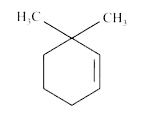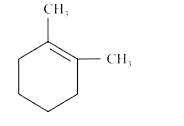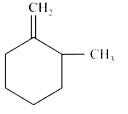1 - Bromo -2, 2 - dimethylcyclohexane on treatment with methanol gives



all of these
The correct Answer is:D
To solve the problem regarding the reaction of 1-bromo-2,2-dimethylcyclohexane with methanol, we will follow these steps:
Step 1: Draw the Structure of 1-Bromo-2,2-Dimethylcyclohexane
1. Start by sketching the cyclohexane ring.
2. Add two methyl groups (–CH₃) at the 2-position.
3. Add a bromine atom (–Br) at the 1-position.
Hint: Remember that the cyclohexane ring is a six-membered carbon ring, and the substituents should be placed according to the IUPAC naming.
Step 2: Identify the Leaving Group
1. In the structure, the bromine (–Br) is a good leaving group.
2. When the compound reacts with methanol, the bromine will leave, creating a carbocation.
Hint: Good leaving groups are usually halogens, and in this case, bromine is known for its ability to leave easily.
Step 3: Formation of Carbocation
1. After bromine leaves, a positive charge (carbocation) is formed on the carbon atom where bromine was attached.
2. The structure now has a carbocation at the 1-position, with two methyl groups still attached at the 2-position.
Hint: A carbocation is a positively charged carbon atom that is often stabilized by adjacent alkyl groups.
Step 4: Possible Rearrangements
1. The carbocation can undergo rearrangement. One possible rearrangement is a 1,2-methyl shift where one of the methyl groups from the 2-position moves to the 1-position.
2. This results in a more stable tertiary carbocation.
Hint: Rearrangements often lead to more stable carbocations, which can influence the products formed.
Step 5: Elimination Reaction with Methanol
1. The carbocation can lose a proton (H⁺) to form a double bond.
2. The double bond can form in several positions:
- Between the 1-position and the 2-position.
- Between the 2-position and the 3-position.
- Between the two methyl groups.
Hint: The elimination reaction typically results in the formation of alkenes, and the position of the double bond can vary based on the stability of the resulting alkene.
Step 6: Possible Products
1. The possible products from this reaction can include:
- An alkene with a double bond between the 1 and 2 positions.
- An alkene with a double bond between the 2 and 3 positions.
- An alkene with a double bond between the two methyl groups.
Hint: Consider the stability of the alkenes formed; more substituted alkenes are generally more stable.
Final Summary
The treatment of 1-bromo-2,2-dimethylcyclohexane with methanol can lead to multiple products due to the formation of a carbocation and subsequent elimination reactions. The main products will be various alkenes formed by the loss of a proton and the formation of double bonds in different positions.
1. Start by sketching the cyclohexane ring.
2. Add two methyl groups (–CH₃) at the 2-position.
3. Add a bromine atom (–Br) at the 1-position.
1. In the structure, the bromine (–Br) is a good leaving group.
2. When the compound reacts with methanol, the bromine will leave, creating a carbocation.
1. After bromine leaves, a positive charge (carbocation) is formed on the carbon atom where bromine was attached.
2. The structure now has a carbocation at the 1-position, with two methyl groups still attached at the 2-position.
1. The carbocation can undergo rearrangement. One possible rearrangement is a 1,2-methyl shift where one of the methyl groups from the 2-position moves to the 1-position.
2. This results in a more stable tertiary carbocation.
1. The carbocation can lose a proton (H⁺) to form a double bond.
2. The double bond can form in several positions:
- Between the 1-position and the 2-position.
- Between the 2-position and the 3-position.
- Between the two methyl groups.
1. The possible products from this reaction can include:
- An alkene with a double bond between the 1 and 2 positions.
- An alkene with a double bond between the 2 and 3 positions.
- An alkene with a double bond between the two methyl groups.
The treatment of 1-bromo-2,2-dimethylcyclohexane with methanol can lead to multiple products due to the formation of a carbocation and subsequent elimination reactions. The main products will be various alkenes formed by the loss of a proton and the formation of double bonds in different positions.
Similar Questions
Knowledge Check
Bromoethane on treatment with alcoholic KOH gives
Aethyl alcoholBbutaneCmethaneDethylene
Benzamide on treatment with POCl3 gives :
View SolutionMaltose on treatment with dilute HCl gives
View SolutionMaltose on treatment with dilute HCl gives:
View SolutionBenzamide on treatment with Br2 and alkali gives
View Solution2−Hexyne gives cis −2− hexene on treatment with :
View Solution2-Hexyne gives trans-2-hexene on treatment with :
View SolutionH2O2 on treatment with chlorine gives:
View Solution

